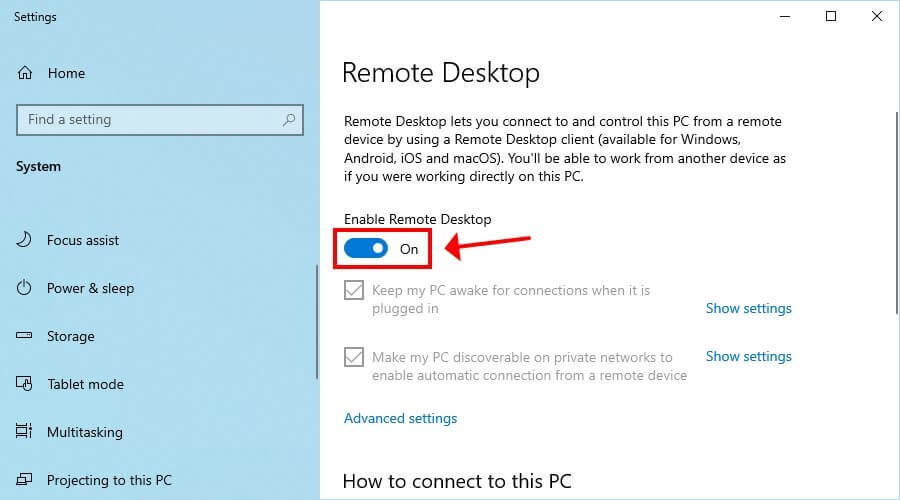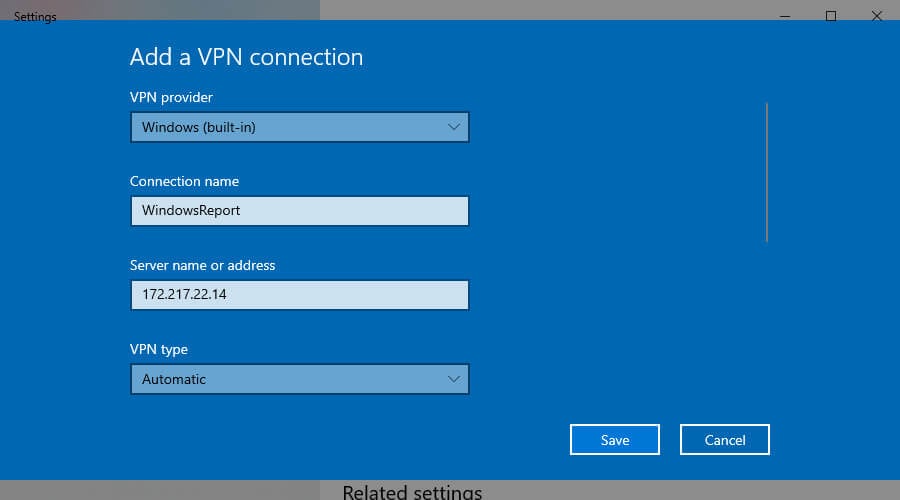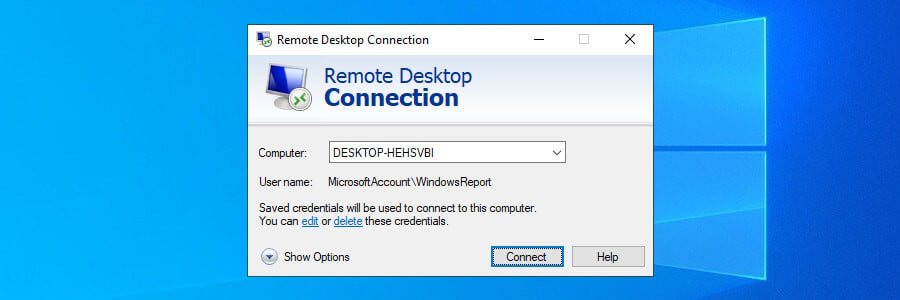- Remote Desktop is a Microsoft free solution you can use to remotely access another Windows PC in the local area network. You can also control a remote PC through the Internet.
- For Internet access, you can forward ports on your router (less secure) or enable VPN connections on the router (more secure). We're showing you the second option in detailed instructions.
- Join our Remote Desktop Connection area to learn more about Microsoft's free remote desktop tool.
- VPNs have cool features but also errors. Visit our VPN Troubleshooting Hub to fix any issues.

If you need to access your home PC from work or a friend’s computer, you can do this easily by turning to remote desktop software. Such tools make it possible to establish a remote connection between two devices so that you can view, edit, delete, download, or upload data with minimum effort – just as if you were sitting in front of the computer.
But there’s a huge difference between LAN-only and Internet access. For example, you can use third-party remote control tools to gain entry to your PC through the Internet. But the best ones aren’t free. Also, they are susceptible to hacker attacks, like TeamViewer that was hacked in 2016.
Microsoft has a free solution called Remote Desktop Connection, which you can use to remotely connect to any PC in the same network. It’s also possible to do this through the Internet in two ways: setting up port forwarding mode on your router or enabling VPN connections on the router.
In the first case, you only need to forward the RDP listening port (default is 3389) to the PC’s local IP address. But it’s dangerous because it means exposing your home network to the web.
The second option is more secure but requires a bit of tinkering: setting up a VPN with Remote Desktop on Windows 10.
Remotely control a PC on the Internet using Remote Desktop with a VPN
A VPN encrypts your network traffic so that, even if a hacker somehow gets hold of your data, they won’t be able to decrypt it. Besides, it has tons of other advantages, like using a VPN for safe crypto-trading on Binance.
We’re showing you the complete steps for setting up a VPN with Remote Desktop on Windows 10. You don’t need to buy anything, so everything here is free to use. However, you can’t finalize the following configuration without a VPN router.
Before getting started, access your router admin panel and look for a VPN server option. Also, keep in mind that: server PC is the computer that you want to access remotely while client PC is the computer used to access the server PC.
1
Allow Remote Desktop connections on the server PC

- Right-click the Windows 10* Start button and go to System.
- Select Remote Desktop.
- Turn on Enable Remote Desktop and click Confirm.
- Write down the PC name.
*Remote Desktop works only with the Windows 10 Pro edition. You can upgrade Windows 10 Home to Windows 10 Pro.
2
Create a VPN server using your router
- Using a web browser, log in to your router admin panel.
- Locate the VPN area and inspect the available protocols.
- If your router supports OpenVPN, then we strongly recommend using it.
- Otherwise, you can enable PPTP.
- For OpenVPN

- Generate an OpenVPN certificate.
- Export the OpenVPN configuration file.
- Upload the OpenVPN config to a safe place.
- Enable the VPN server.
- For PPTP

- Create a username and password required to connect to the server PC.
- Enable the VPN server.
- Ask Google what’s your public IP address and write it down.
Can’t get the VPN to work on your router? Our guide shows simple steps to quickly fix it.
If you have a dynamic IP address, consider registering for a dynamic DNS server and using it for VPN connections and remote desktop connections. It might be possible to request a static IP address from your ISP or set up a secondary IP address and make it static. Otherwise, devices will not be able to remotely connect to the PC once the IP address changes.
When in doubt, always use OpenVPN
OpenVPN is a modern and safe protocol that can truly protect you from eavesdroppers and hackers. If your router supports it, we highly suggest using it because it surpasses PTTP.
Your security is ensured by the certificate and private key included in the config file. OpenVPN is an excellent solution for home and business users alike.
However, it comes with some inconveniences. For example, if you generate a new certificate through your router’s firmware, you have to replace the old certificate from the client device with the new one. You must also install an OpenVPN client (for free) on every device you wish to use for remote connections.
PPTP might be easier, but it’s less secure
PPTP is one of the oldest protocols, and it’s native to most platforms. That means that you don’t have to install any additional software since you can create a manual PPTP VPN connection using the Windows 10 built-in VPN provider or the integrated PPTP support of another OS.
Furthermore, since it doesn’t use too many resources, it’s ideal for older computers that can’t take the heat of modern VPN protocols like OpenVPN. Most routers support PPTP but few of them work with OpenVPN.
Unfortunately, PPTP can be easily hacked. In fact, many VPN companies and other security groups consider that PPTP is now obsolete, and they strongly advise against using it. For example, using PPTP VPN in corporations is out of the question.
3
Set up a VPN connection on the client PC
For PPTP

- On Windows 10, click the Start button or press Win key.
- Type VPN settings and press Enter.
- Click Add a VPN connection and set the following:
- VPN provider to Windows (built-in).
- Connection name to any display name.
- Server name or address to the public IP address* of the server PC.
- VPN type to Point to Point Tunneling Protocol (PPTP).
- Type of sign-in info to User name and password.
- User name (optional) and Password (optional) to the account info you specified in the router panel for PPTP.
- Check Remember my sign-in info.
- Click Save.
- Select the VPN connection and click Connect.
*You previously obtained this information when you asked Google what’s your IP. If you registered for dynamic DNS, write the name server instead of the IP address.
If the PPTP connection isn’t working, make sure to troubleshoot the issue.
For OpenVPN

- Download OpenVPN GUI for Windows 10.
- Install the tool with default settings.
- Download the OpenVPN config file you created from the router panel.
- Right-click the OpenVPN GUI systray icon and click Import file.
- Select the OpenVPN config file from your router.
- Right-click the OpenVPN GUI systray icon and select Connect.
If OpenVPN GUI won’t work on your PC, you can easily diagnose and fix the problem.
4
Connect to the server PC using Remote Desktop

- On Windows 10*, click Start or press Win key.
- Type Remote Desktop Connection and press Enter.
- Set Computer to the PC name**.
- Click Connect.
- When prompted for the password***, write it down.
- Congratulations! You have connected to another PC remotely through VPN.
*You can also download Remote Desktop for Windows 10, Android, and iOS to remotely connect to a Windows PC.
**You wrote down the PC name when allowing Remote Desktop connections on the server PC.
***Make sure the user account matches the one you gave permission to remotely connect through Remote Desktop.
Having connection issues with Remote Desktop on Windows 10? Our quick-fix guide explains exactly what you need to do.
To summarize, you can remotely connect to another PC using Remote Desktop from anywhere in the world with the help of a VPN and a router that has native support for VPN connections.
It’s a much safer solution than the alternative, where you have to expose the network to the Internet by setting up port forwarding mode on your router. By connecting to a VPN before making the Remote Desktop connection, you encrypt all data traffic and protect it from any eavesdroppers.
Besides, if you get equipped with a powerful VPN client, you can access blocked websites, evade geoblocks, unblock unavailable Netflix catalogs, reduce your ping while gaming, and much more. If you’re interested in crypto, you can also use a VPN for Bitcoin trading and mining.
FAQ: Learn more about Remote Desktop and VPN
RDP VPN refers to using remote desktop software to control a remote PC through the Internet securely by connecting to a VPN instead of enabling port forwarding on the router.
- What’s the difference between VPN and Remote Desktop?
Using a VPN, you connect to a remote network and become a LAN device to access shared files and printers, map network drives through VPN, and more. With Remote Desktop, you remotely control another PC and automatically access its LAN. But you can use a VPN and Remote Desktop at the same time to increase your security and privacy.
Yes, RDP is safer when using a VPN to encrypt your data traffic. It depends on the VPN protocol and encryption you use. We suggest OpenVPN with 256-bit AES.
and
If you are looking for a cheap and genuine microsoft product key, warranty for 1 year.
It will be available at the link: https://officerambo.com/shop/
Microsoft Windows Embedded 8.1 Industry Pro : https://officerambo.com/product/windows-embedded-8-1/
Key Windows 7 Professional / Home Base / Home Premium (2 USER) : https://officerambo.com/product/key-windows-7/
Microsoft Windows 8.1 PRO (2 PC) : https://officerambo.com/product/microsoft-windows-8-1-pro/
Windows Server 2012 R2 : https://officerambo.com/product/windows-server-2012-r2/
Visual Studio Enterprise 2019 : https://officerambo.com/product/visual-studio-enterprise-2019/
Windows Server Standard / Datacenter / Essentials : https://officerambo.com/product/windows-server-all-version-standard-datacenter-essentials/
Microsoft Office Professional Plus for Windows : https://officerambo.com/product/microsoft-office-professional-plus-for-windows/
Microsoft Office Home and Student for Windows : https://officerambo.com/product/microsoft-office-home-and-student/
Key Microsoft Access 2016 : https://officerambo.com/product/key-microsoft-access-2016/
Microsoft Visio Professional : https://officerambo.com/product/microsoft-visio-professional/
Microsoft Project Professional : https://officerambo.com/product/microsoft-project-professional/
Account Microsoft Office 365 Profestional Plus 2020 Update For 5 Devices : https://officerambo.com/product/account-microsoft-office-365/
Key Microsoft Windows 10 Profestional / Profestional N : https://officerambo.com/product/key-microsoft-windows-10/
Key Microsoft Windows XP Pro : https://officerambo.com/product/key-microsoft-windows-xp-pro/
Microsoft Office Home and Business for Mac : https://officerambo.com/product/microsoft-office-home-and-business-for-mac/
No comments:
Post a Comment